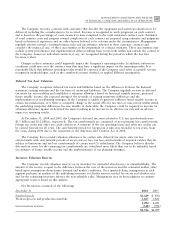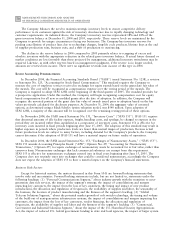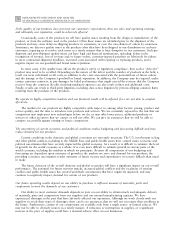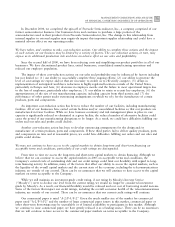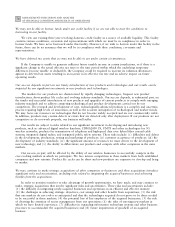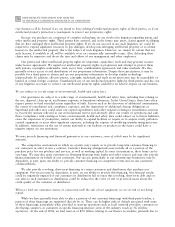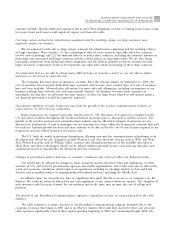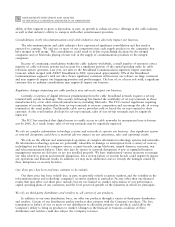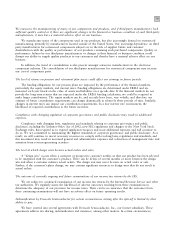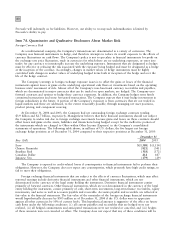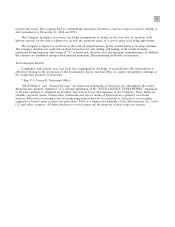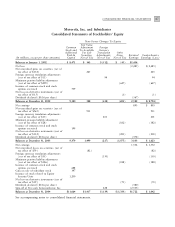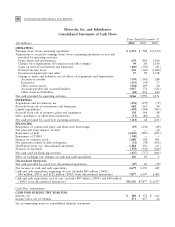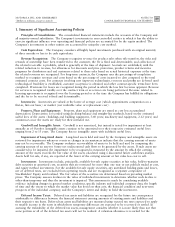Motorola 2004 Annual Report Download - page 87
Download and view the complete annual report
Please find page 87 of the 2004 Motorola annual report below. You can navigate through the pages in the report by either clicking on the pages listed below, or by using the keyword search tool below to find specific information within the annual report.
79
We outsource the manufacturing of many of our components and products, and if third-party manufacturers' lack
suÇcient quality control or if there are signiÑcant changes in the Ñnancial or business condition of such third-party
manufacturers, it may have a material adverse eÅect on our business.
We manufacture many of the components used in our products, but also increasingly depend on outsourced
manufacturing, primarily by manufacturers located outside of the United States. Our increasing dependence on third
party manufacturers for outsourced components subjects us to the risk of supplier failure and customer
dissatisfaction with the quality or performance of our products containing such purchased components. Quality or
performance failures by our third-party manufacturers or changes in their Ñnancial or business condition could
disrupt our ability to supply quality products to our customers and thereby have a material adverse eÅect on our
business.
In addition, the trend of consolidation is also present amongst outsource manufacturers in the electronic
component industry. The consolidation of our third-party manufacturers for outsourced components may increase
our cost of component parts.
The level of returns on pension and retirement plan assets could aÅect our earnings in future periods.
The funding obligations for our pension plans are impacted by the performance of the Ñnancial markets,
particularly the equity markets, and interest rates. Funding obligations are determined under ERISA and are
measured each year based on the value of assets and liabilities on a speciÑc date. If the Ñnancial markets do not
provide the long-term returns that are expected under the ERISA funding calculation, we could be required to
make larger contributions. The equity markets can be, and recently have been, very volatile, and therefore our
estimate of future contribution requirements can change dramatically in relatively short periods of time. Similarly,
changes in interest rates can impact our contribution requirements. In a low interest rate environment, the
likelihood of required contributions in the future increases.
Compliance with changing regulation of corporate governance and public disclosure may result in additional
expenses.
Compliance with changing laws, regulations and standards relating to corporate governance and public
disclosure, including the Sarbanes-Oxley Act of 2002, new SEC regulations and changes to the New York Stock
Exchange rules, has required us to expend signiÑcant resources and incur additional expenses and will continue to
do so. We are committed to maintaining the highest standards of corporate governance and public disclosure. As a
result, we will continue to invest necessary resources to comply with evolving laws, regulations and standards, and
this investment may result in increased general and administrative expenses and a diversion of management time and
attention from revenue-generating activities.
The level at which design wins become actual orders and sales.
A ""design win'' occurs when a customer or prospective customer notiÑes us that our product has been selected
to be integrated with the customer's product. There can be delays of several months or more between the design
win and when a customer initiates actual orders. The design win may never become an actual order or sale.
Further, if the customer's plans change, we may commit signiÑcant resources to design wins that do not result in
actual orders.
The outcome of currently ongoing and future examinations of our income tax returns by the IRS.
We are subject to continued examination of our income tax returns by the Internal Revenue Service and other
tax authorities. We regularly assess the likelihood of adverse outcomes resulting from these examinations to
determine the adequacy of our provision for income taxes. There can be no assurance that the outcomes from
these continuing examinations will not have an adverse eÅect on future operating results.
IndemniÑcation by Freescale Semiconductor for certain circumstances arising after the spin-oÅ is limited by their
ability to pay.
We have entered into several agreements with Freescale Semiconductor, Inc., our former subsidiary. These
agreements address tax sharing, indemniÑcation and insurance, among other matters. In certain circumstances,


